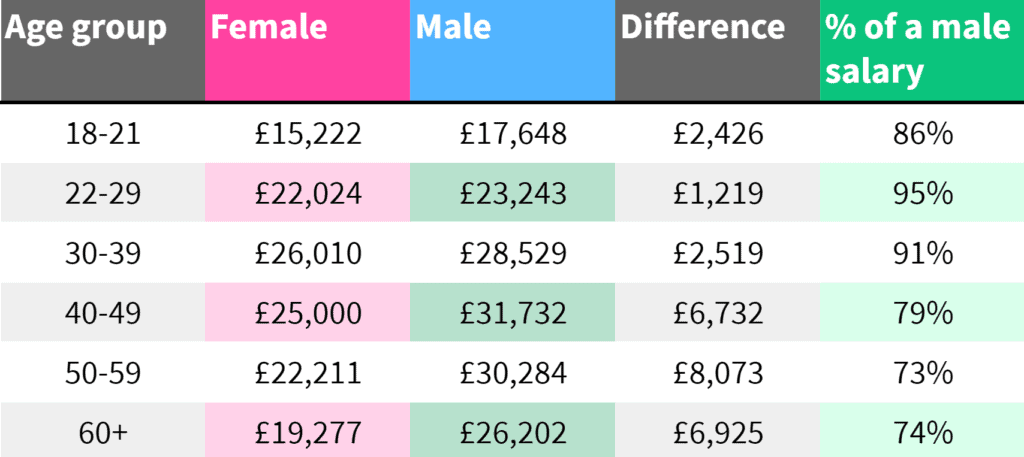Executive search firm, Anthony Gregg Partnership has compiled the latest data from the ONS Annual Survey of Hours and Earnings to spotlight the salaries of men and women working in the retail sector, highlighting the pay discrepancies between the two.
Despite more than 50 years since the passing of the Equal Pay Act, the gender pay gap remains a prevalent issue in the UK. The gap may be shrinking, but there is still a long way to go to eliminate salary disparities, particularly in higher seniority roles, new data has shown.
The tendency for women to work fewer hours than their male counterparts and occupy roles in lower-paying industries, such as health and social work, has often been labelled as the reason behind the gender pay gap. This executive search consultancy has taken a closer look at men and women, specifically in full-time roles in the retail industry, proving the root of the gender pay gap goes further than the hours worked.
The data reveals that in 2020 there was a gender pay gap of 15.5% among all employees, down from 17.4% in 2019 and 17.8% in 2018. Although there has been some improvement, this still means that for every £1 earned by a man, his female equivalent will only earn 85p. The wage gap among managers, directors and senior officials across all industries follows this trend and has fallen from 16.2% to 11.3%, below the average.
However, when focusing on the retail and wholesale sector, the data reveals that female managers and directors in this sector suffered an increase of 1.9% in the wage gap, being paid on average 21.1% less than their male counterparts. In this industry, women in managerial and directorial roles also experienced a much greater wage gap when compared to those in less senior positions. The earnings gap for women in assistant and cashier roles was only 2.2% — significantly lower than the 15.5% average for all employees and only a tenth of the gap for senior retail roles.
The wage gap seems to have remained relatively consistent for women in managerial and directorial positions over the last few years. However, a further look back at the trend over the last decade shows that the improvement in the pay disparity has lost momentum. Without a clear downward trend in the pay gap, much remains to be done to achieve wage parity.
In the last year, the gender pay gap for managers and directors began to widen, although only by 1.9%. This reflects negatively on the progress for wage parity in retail. However, based on previous year-on-year changes, it is likely that this sector will continue to follow the overall trend of the previous few years.
Aside from a spike in 2019, the wage gap for assistant-level roles has also remained relatively consistent, making only incremental changes in both directions.
What does the gender pay gap in retail look like?
In 2020, there was still a clear difference between the average salaries earned by men and women, with women working in retail earning 18% less on average than their male counterparts. The average salary difference of over £6000 per annum could equate to more than two months pay or a loss of £250,000 over a 40 year career.
Does The Gender Pay Gap Close with Age?
Women consistently earn less than their male counterparts throughout their lives. The table below breaks down the percentage difference in women’s salaries across different age groups.

The data shows that the wage gap was the lowest in the age groups pertaining to young working professionals, and increased significantly with age. Women over 50 suffer the largest gap, earning on average less than three-quarters of what men in the same industry earn. This could point to how more time spent in a woman’s career does not always equate to career progression, as outlined in a study by PayScale that found that women tend to move up the career ladder at a slower pace than men.
The following table shows how the retail industry is dominated by men across the majority age groups. The only exception is the over 60s age group which accounts for only 11.5% of the total jobs in the industry.
What does the retail sector need to do to further bridge the gender pay gap?
The data gathered points to a relatively static wage gap within the retail sector. Nonetheless, there are efforts retailers can make to address disparities within their workforce. Employers should be more transparent with salary information and decisions made regarding pay to increase accountability. Employers can also shift their working practices away from a focus on long hours, particularly in senior roles, that studies have shown to exacerbate the gender pay gap.
Tackling workplace inequality involves looking at the bigger picture and addressing the opportunity gap alongside the pay gap. A study by PWC points out that pay gaps are primarily driven by the lower proportion of senior roles filled by women in retailers in the UK. Moving forward, employers in the retail sector should focus on initiatives that encourage the advancement of women’s careers, including mentoring schemes and access to opportunities.
Eliminating the gender pay gap in the retail sector will not happen overnight. The introduction of these schemes should be combined with implementing more of a culture of flexibility as part of long term action plans to change gender preconceptions and close the wage gap.
At AGP, we offer unrivalled and industry recognised retail executive search services across the UK and Europe. Get in touch today.


